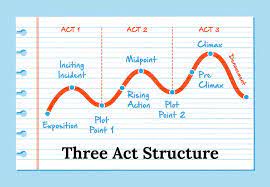Part 13: 3-act story structure
So, for every basic story, there is a story structure. This structure is called as the '3-act story structure'. What is the three act story structure?

Exposition - It is the background information on the characters and setting explained at the beginning of the story. The EXPOSITION will often have information about events that happened before the story began. Basically, you have to give background checks on your main characters in the exposition.
Inciting incident (1) - The incident that changes the main character or characters' life to 360 degree level. Life changing first event. The inciting incident of a story is the event that sets the main character or characters on the journey that will occupy them throughout the narrative. ... In moments big and small, an inciting incident changes the life of a character, and the ensuing story is the fallout from that change.
For example, the moment Effie calls out Primrose Everdeen, Katniss chooses to volunteer. The choice she makes in that moment of The Hunger Games book was the inciting incident. In Harry Potter and the Philosopher's Stone, Hagrid showing up to tell Harry he's a wizard is the inciting moment.
Plot point 1 - The first plot point in a story serves as the point of no return for the main character. It occurs in the first act (usually around a quarter or a third of the way through the story) and propels the main character into the central conflict of the story, breaking away from the status quo.
For example - Katniss agrees to the hunger games, after the inciting incident (where she volunteers against Primrose, her sister) she has no turning back. Next events detail how they drag her towards the hunger games. Now, she has no choice but to participate in the hunger games. Note that Primrose telling her to win as well as Gale telling her to make or take a bow are also in means that she has no turning back from the hunger games.
These subtle clues to denote that your character has no choice but to turn up to this specific event or someone is inevitable. They have no choice but to continue. You can make this up with series of logical events that lead up the main character to this plot point and another set of events that result in forcing the main character to take this action.
Rising action - The rising action of the story is all of the events that lead to the eventual climax, including character development and events that create suspense. Climax. The climax is the most exciting point of the story, and is a turning point for the plot or goals of the main character.
For an example, A character in a story wants to audition for the leading role in the school play, but so does his best friend, so the character has to decide what he will do.
Midpoint - The Midpoint is a major plot point that occurs right around — you guessed it — the middle of the screenplay or the book. A plot point's function is to move the protagonist closer to or farther from his or her goal. So a Midpoint does that, but usually in a more pronounced way than smaller plot points and milestones.
So, there can be one or more midpoints, just don't overuse it every time.
For an example, the character in the story makes the decision that he/she/they is/are going to the school play, despite whatever is going to happen.
Pre climax - The pre climax means a climax that occurs before the real and the main climax, so it's a misleading stage (if genre is especially a thriller or suspense) it's kind of a high point of tension but not the real one. It misleads the readers into believing something that is proven to be wrong or right in the main climax.
For an example - The pre climax of Pride and Prejudice is Darcy confessing that he loves Elizabeth, but Elizabeth turning down his offer. As you know, this makes readers believe they're not going to end up together but the real climax proves the readers that they're wrong.
You can have either pre-climax or climax if it's genres like Fantasy or Romance but if it's thriller or suspense, this element is vital.
Climax - This is the real, highest point of tension. This is the 'aha' moment. The ultimate moment of truth. Now, you reveal to the readers that they were wrong or right about what they thought.
Ex - It turns out the climax was that Lydia eloped with Wickham and Darcy saved them from dishonour becomes to shift Elizabeth from falling in love with Darcy immediately. Now, the readers, whom believed Darcy and Elizabeth are not going to end up, is proved wrong because now Elizabeth has fallen for him.
There can be many inciting incidents, just make sure you put them in a certain series.
Plan out your book's following with incidents to the 3-act story structure given above.
Bạn đang đọc truyện trên: AzTruyen.Top